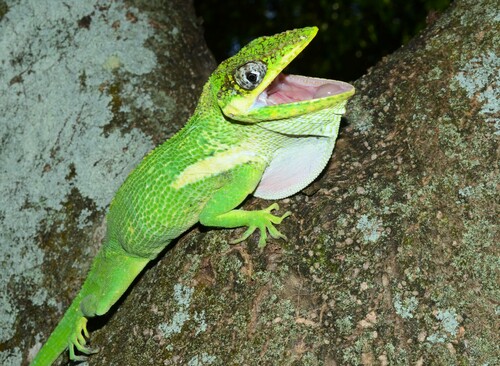
Knight Anole
The Cuban Knight Anole (Anolis equestris) dazzles with its vivid green hue and striking dewlap. This agile climber thrives in Cuba's lush forests, showcasing its prowess in the arboreal world. With a diet spanning insects to small vertebrates, it plays a vital role in controlling pest populations.
137.0 g
Weight
Length: 33 - 51 cm
Size
Yellow, Green
Color
2 years
Age of Sexual Maturity
Medium
Aggression
Least Concern
Conservation Status
Unknown
Population Trend
Characteristics
Anolis equestris, commonly known as the Cuban Knight Anole, is a large species of lizard native to Cuba. It exhibits bright green coloration, often with a yellow stripe on the side, and can change color slightly based on mood or temperature. Known for its dewlap—a flap of skin under the throat—it is used in territorial displays and communication. These arboreal reptiles are typically found in trees within subtropical forests and are known for their agility and climbing prowess. They primarily feed on insects, but also consume fruits and small vertebrates.
Distribution Range of the Knight Anole
The Cuban knight anole (Anolis equestris) is native to Cuba. It is also found in some of the nearby islands in the Caribbean.
Knight Anole's Habitat
Environmental Conditions
Anolis equestris typically inhabits subtropical and tropical moist lowland forests. The species is also commonly found in urban areas with sufficient tree cover. They prefer locations with abundant vegetation, which provides cover and climbing opportunities.
Ecological Niche
As an arboreal lizard, Anolis equestris primarily occupies the mid to upper canopy of trees. It is diurnal, meaning it is active during the day, and it is an insectivore, feeding on a variety of insects and other small invertebrates. The species is known for its territorial behavior, often establishing territories in trees where males display to attract females and deter rivals.
Copyright @ Nature Style Limited. All Rights Reserved.
 English
English